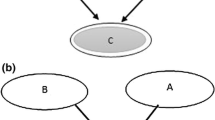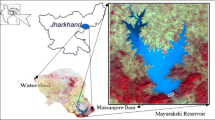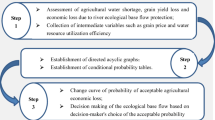Abstract
Dam inflow prediction is important in terms of optimal water allocation and reduction of potential risks of floods and droughts. It is necessary to select a suitable model to reduce uncertainties in long-term and short-term predictions. In this study a probabilistic model of Bayesian Networks (BNs) was used to evaluate its efficiency in predicting inflow into reservoirs considering the uncertainties. For this purpose, continuous BNs as well as integration of K-means clustering and discrete BNs were applied for predicting magnitude and range of inflows, respectively in terms of annual and monthly prediction scenarios. In this regard, the Zayandehrud Dam reservoir in Iran was selected to test this model. To achieve the best network structure in these scenarios, different patterns were defined based on the combination of predictors. According to the magnitude predictions, the MAPE and R2 indicators in annual model were respectively 21% and 0.62 and in monthly model were respectively 49% and 0.71. According to the results of the inflow range prediction, the prediction accuracy of the annual and monthly patterns was 75% and 83%, respectively. Modelling results showed that BN performs better in predicting the inflow range than its numerical prediction. The proposed model can improve the decision making of reservoirs operation.








Similar content being viewed by others
References
Abebe Y, Kabir G, Tesfamariam S (2018) Assessing urban areas vulnerability to pluvial flooding using GIS applications Bayesian belief network model. J Clean Prod 174:1629–1641
Ahmadi A, Karamouz M, Moridi A (2010) Robust methods for identifying optimal reservoir operation strategies using deterministic and stochastic formulations. Water Resour Manag 24(11):2527–2552
Albalate A, Suendermann D (2009) A combination approach to cluster validation based on statistical quantiles. International Joint Conference on Bioinformatics, Systems Biology and Intelligent Computing, Agust 3–5 , Shanghai, China: 549–555
Allawi MF, Jaafar O, Hamzah FM, Abdullah SMS, El-shafie A (2018) Review on applications of artificial intelligence methods for dam reservoir-hydro-environment models. Environmental Science Pollution Research 25(14):1–24
Anbari MJ, Tabesh M, Roozbahani A (2017) Risk assessment model to prioritize sewer pipes inspection in wastewater collection networks. J Environ Manag 190:91–101
Asadilour M, Kaveh F, Manshuri M, Khosrojerdi A (2012) Developing decision support tools for optimum domestic management by Bayesian belief networks in Tehran, Iran. Adv Environ Biol 6(1):286–296
Atiquzzaman M, Kasamy J (2016) Prediction of inflows from dam catchment using genetic programming. International Journal of Hydrology Science Technology 6(2):103–117
Awan JA, Bae DH (2013) Application of adaptive neuro-fuzzy inference system for dam inflow prediction using long-range weather forecast. Digital information management (ICDIM), eighth international conference on IEEE, september 10-12, Islamabad, Pakistan: 247-251
Awan JA, Bae DH (2014) Improving ANFIS based model for long-term dam inflow prediction by incorporating monthly rainfall forecasts. Water Resour Manag 28(5):1185–1199
Bae DH, Jeong DM, Kim G (2007) Monthly dam inflow forecasts using weather forecasting information and neuro-fuzzy technique. Hydrol Sci J 52(1):99–113
Bae DH, Son KH, So JM (2017) Utilization of the Bayesian method to improve hydrological drought prediction accuracy. Water Resour Manag 31(11):3527–3541
Chiamsathit C, Adeloye AJ, Bankaru-Swamy S (2016) Inflow forecasting using artificial neural networks for reservoir operation. Proceedings of the International Association of Hydrological Sciences 373:209–214
Couture RM, Moe SJ, Lin Y, Kaste Ø, Haande S, Solheim AL (2018) Simulating water quality and ecological status of Lake Vansjø, Norway, under land-use and climate change by linking process-oriented models with a Bayesian network. Sci Total Environ 621:713–724
Das M, Ghosh SK, Chowdary VM, Saikrishnaveni A, Sharma RK (2016) A probabilistic nonlinear model for forecasting daily water level in reservoir. Water Resour Manag 30(9):3107–3122
Das M, Ghosh SK, Gupta P, Chowdary VM, Nagaraja R, Dadhwal VK (2017) Forward: a model for forecasting reservoir water dynamics using spatial bayesian network (spabn). IEEE Trans Knowl Data Eng 29(4):842–855
Esmaeilzadeh B, Sattari MT, Samadianfard S (2017) Performance evaluation of ANNs and M5 model tree in Sattarkhan reservoir inflow prediction. ISH Journal of Hydraulic Engineering 23(3):283–292
Froelich W (2015) Forecasting daily urban water demand using dynamic Gaussian Bayesian network. International conference of beyond databases, architectures and structures, may 30 – June 2 Ustron, Poland: 333-342
Goodarzi R, Banihabib ME, Roozbahani A (2019) A decision-making model for flood warning system based on ensemble forecasts. J Hydrol 573:207–219
Gholamzadeh M, Morid S, Delavar M (2011) Application of drought early warning system for operation of Zayandehrud dam. Journal of Water and Soil Science 15(56):35–48
Ghordoyee Milan S, Roozbahani A, Banihabib ME (2018) Fuzzy optimization model and fuzzy inference system for conjunctive use of surface and groundwater resources. J Hydrol 566:421–434
Hall DC, Le QB (2017) Use of Bayesian networks in predicting contamination of drinking water with E. coli in rural Vietnam. Trans R Soc Trop Med Hyg 111(6):270–277
Hugin Expert A/S (2017). Hugin Researcher User Guide, Version 8.5(Aalborg,Denmark)
Humphrey GB, Gibbs MS, Dy GC, Maier HR (2016) A hybrid approach to monthly streamflow forecasting: integrating hydrological model outputs into a Bayesian artificial neural network. J Hydrol 540:623–640
Javadi S, Hashemy SM, Mohammadi K, Howard KWF, Neshat A (2017) Classification of aquifer vulnerability using K-means cluster analysis. J Hydrol 549:27–37
Kabir G, Tesfamariam S, Sadiq R (2015) Predicting water main failures using Bayesian model averaging and survival modelling approach. Reliab Eng Syst Saf 142:498–514
Kim K, Lee S, Jin Y (2018) Forecasting quarterly inflow to reservoirs combining a copula-based Bayesian network method with drought forecasting. Water 10(2):233
Kumar S, Tiwari MK, Chatterjee C, Mishra A (2015) Reservoir inflow forecasting using ensemble models based on neural networks, wavelet analysis bootstrap method. Water Resour Manag 29(13):4863–4883
Leu SS, Bui QN (2016) Leak prediction model for water distribution networks created using a Bayesian network learning approach. Water Resour Manag 30(8):2719–2733
Li C, Bai Y, Zeng B (2016) Deep feature learning architectures for daily reservoir inflow forecasting. Water Resour Manag 30(14):5145–5161
Liu Y, Engel BA, Flanagan DC, Gitau MW, McMillan SK, Chaubey I, Singh S (2018) Modelling framework for representing long-term effectiveness of best management practices in addressing hydrology and water quality problems: framework development and demonstration using a Bayesian method. J Hydrol 560:530–545
MacQueen J (1967) Some methods for classification and analysis of multivariate observations. Proceedings of the fifth Berkeley symposium on mathematical statistics and probability, Oakland, CA, USA 1(14):281–297
Madadgar S, Moradkhani H (2014) Spatio-temporal drought forecasting within Bayesian networks. J Hydrol 512:134–146
Magiera E, Froelich W (2015) Application of Bayesian networks to the forecasting of daily water demand. Intelligent Decision Technologies, Springer: 385–393
Mediero L, Garrote L, Martin-Carrasco F (2007) A probabilistic model to support reservoir operation decisions during flash floods. Hydrol Sci J 52(3):523–537
Mohajerani H, Kholghi M, Mosaedi A, Farmani R, Sadoddin A, Casper M (2017) Application of bayesian decision networks for groundwater resources management under the conditions of high uncertainty and data scarcity. Water Resour Manag 31(6):1859–1879
Molina JL, Bromley J, García-Aróstegui JL, Sullivan C, Benavente J (2010) Integrated water resources management of overexploited hydrogeological systems using object-oriented Bayesian networks. Environ Model Softw 25(4):383–397
Nagarajan K, Krekeler C, Slatton KC, Graham WD (2010) A scalable approach to fusing spatiotemporal data to estimate streamflow via a Bayesian network. IEEE Trans Geosci Remote Sens 48(10):3720–3732
Nasri M (2010) Application of artificial neural networks (ANNs) in prediction models in risk management. World Appl Sci J 10(12):1493–1500
Nodoushan EJ (2018) Monthly forecasting of water quality parameters within Bayesian networks: a case study of Honolulu, Pacific Ocean. Civil Engineering Journal 4(1):188–199
Pearl J (1988) Probabilistic reasoning in intelligent systems: networks of plausible reasoning. Morgan Kaufmann Publishers, Los Altos
Phan TD, Sahin O, Smart JC (2016) System dynamics and Bayesian network models for vulnerability and adaptation assessment of a coastal water supply and demand system. Proceedings of the 8th international congress on environmental Modelling and software: supporting sustainable futures, July 10-14, Toulouse, France :1180-1187
Rahman MM, Hagare D, Maheshwari B (2016) Bayesian belief network analysis of soil salinity in a peri-urban agricultural field irrigated with recycled water. Agric Water Manag 176:280–296
Rendón E, Abundez I, Arizmendi A, Quiroz EM (2011) Internal versus external cluster validation indexes. International Journal of computers communications 5(1):27–34
Roozbahani A, Ebrahimi E, Banihabib ME (2018) A framework for ground water management based on Bayesian network and MCDM techniques. Water Resour Manag 32(15):4985–5005
Ropero RF, Flores MJ, Rumi R, Aguilera PA (2017) Applications of hybrid dynamic Bayesian networks to water reservoir management. Environmetrics 28:1–11
Sharifahmadian E, Latifi S (2013) Water environment risk prediction using Bayesian network. Proceedings of the IEEE SoutheastCon,April 4–7, Jacksonville, Florida, USA: 1–5
Sherafatpour Z, Roozbahani A, Hasani Y (2019) Agricultural water allocation by integration of hydro-economic modeling with Bayesian networks and random Forest approaches. Water Resour Manag 33(7):2277–2299
Sikorska AE, Seibert J (2016) Value of different precipitation data for flood prediction in an alpine catchment: a Bayesian approach. Journal of hydrology 556:961–971
Tabesh M, Roozbahani A, Roghani B, Faghihi NR, Heydarzadeh R (2018) Risk assessment of factors influencing non-revenue water using Bayesian networks and fuzzy logic. Water Resour Manag 32(11):1–24
Xue J, Gui D, Lei J, Zeng F, Mao D, Zhang Z (2017) Model development of a participatory Bayesian network for coupling ecosystem services into integrated water resources management. J Hydrol 554:50–65
Xue J, Gui D, Zhao Y, Lei J, Zeng F, Feng X, Shareef M (2016) A decision-making framework to model environmental flow requirements in oasis areas using Bayesian networks. J Hydrol 540:1209–1222
Acknowledgments
The authors would like to acknowledge the financial support of Regional Water Company of Isfahan in Iran for this research under grant number 95/185.
Author information
Authors and Affiliations
Corresponding author
Ethics declarations
Conflict of Interest
None.
Additional information
Publisher’s Note
Springer Nature remains neutral with regard to jurisdictional claims in published maps and institutional affiliations.
Rights and permissions
About this article
Cite this article
Noorbeh, P., Roozbahani, A. & Kardan Moghaddam, H. Annual and Monthly Dam Inflow Prediction Using Bayesian Networks. Water Resour Manage 34, 2933–2951 (2020). https://doi.org/10.1007/s11269-020-02591-8
Received:
Accepted:
Published:
Issue Date:
DOI: https://doi.org/10.1007/s11269-020-02591-8




